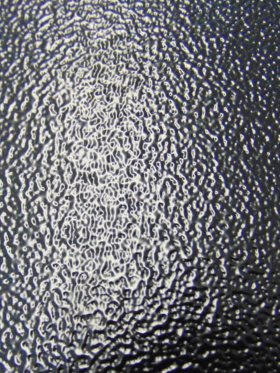Orange Peel
TRB0014
A mottled, uneven surface which often has the appearance of the skin of an orange, (thus the name)! This is generally only seen when applying by spray.
Causes
- Gun settings are incorrect. This most commonly will be air pressure is too high or too low but can also be caused by spraying too far away from the panel or too close. Wide fan patterns or very thin gun patterns can also cause this effect.
- Thinner used is too fast.
- Paint being under diluted not allowing the paint to “wet out” properly.
- Paint applied too dry, (see dry spraying troubleshooting article).
- Spraying temperature excessively hot or cold.
- Paint not uniformly mixed.
Prevention
- Make sure products are being applied with the recommended gun settings, at an appropriate distance from the substrate and with the correct tip size.
- Make sure air pressures are correct, (optimal is where atomisation of the paint is obtained but there is not excessive amounts of overspray).
- Topcoats should be applied in a steady, controlled and methodical manner. Apply evenly consistent with good flow over the substrate.
- Avoid spraying when the temperature is especially hot or cold. Especially when the temperature is warm a slower thinner should be used. Ideal spraying temperature is 20-25 °C.
- Make sure the correct amount of thinner is being used. If orange peel is evident on the surface slight overthinning is sometimes permissible and can solve the issue.
- Use the correct thinner for application conditions, (slow, mid, fast etc.).
- Make sure paint is properly mixed before application.
Rectification
Minor orange peel may be helped by flatting and polishing with compounds. In severe cases the surface may need sanding to a smooth surface and refinishing. Make sure when refinishing that the preventative steps above are followed.
